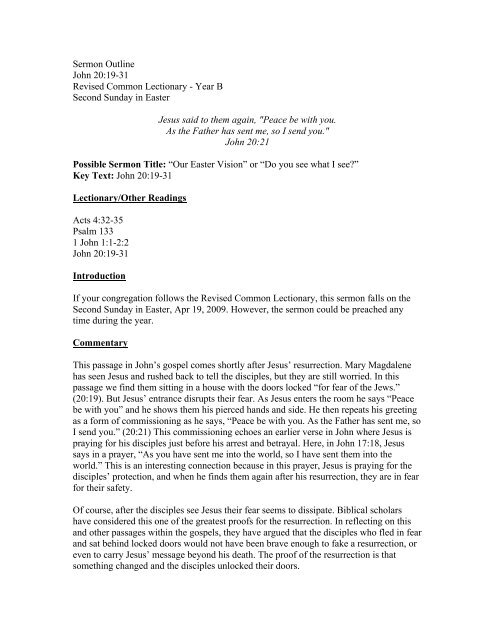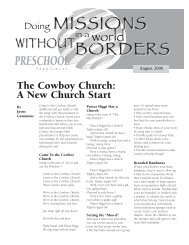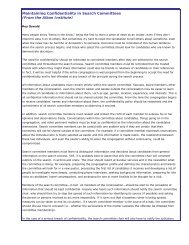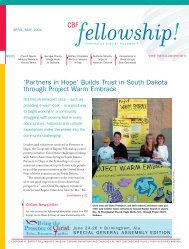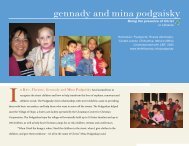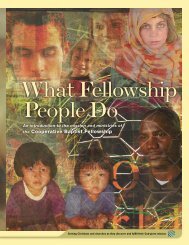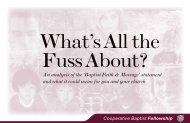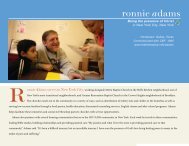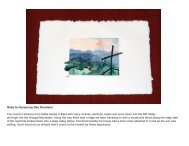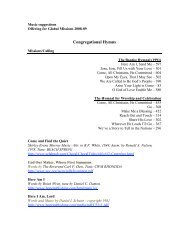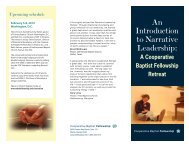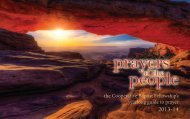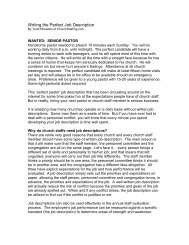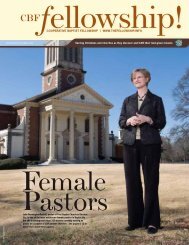Missional Sermon Outline
Missional Sermon Outline
Missional Sermon Outline
Create successful ePaper yourself
Turn your PDF publications into a flip-book with our unique Google optimized e-Paper software.
<strong>Sermon</strong> <strong>Outline</strong>John 20:19-31Revised Common Lectionary - Year BSecond Sunday in EasterJesus said to them again, "Peace be with you.As the Father has sent me, so I send you."John 20:21Possible <strong>Sermon</strong> Title: “Our Easter Vision” or “Do you see what I see?”Key Text: John 20:19-31Lectionary/Other ReadingsActs 4:32-35Psalm 1331 John 1:1-2:2John 20:19-31IntroductionIf your congregation follows the Revised Common Lectionary, this sermon falls on theSecond Sunday in Easter, Apr 19, 2009. However, the sermon could be preached anytime during the year.CommentaryThis passage in John’s gospel comes shortly after Jesus’ resurrection. Mary Magdalenehas seen Jesus and rushed back to tell the disciples, but they are still worried. In thispassage we find them sitting in a house with the doors locked “for fear of the Jews.”(20:19). But Jesus’ entrance disrupts their fear. As Jesus enters the room he says “Peacebe with you” and he shows them his pierced hands and side. He then repeats his greetingas a form of commissioning as he says, “Peace be with you. As the Father has sent me, soI send you.” (20:21) This commissioning echoes an earlier verse in John where Jesus ispraying for his disciples just before his arrest and betrayal. Here, in John 17:18, Jesussays in a prayer, “As you have sent me into the world, so I have sent them into theworld.” This is an interesting connection because in this prayer, Jesus is praying for thedisciples’ protection, and when he finds them again after his resurrection, they are in fearfor their safety.Of course, after the disciples see Jesus their fear seems to dissipate. Biblical scholarshave considered this one of the greatest proofs for the resurrection. In reflecting on thisand other passages within the gospels, they have argued that the disciples who fled in fearand sat behind locked doors would not have been brave enough to fake a resurrection, oreven to carry Jesus’ message beyond his death. The proof of the resurrection is thatsomething changed and the disciples unlocked their doors.
So Jesus sends the disciples out, but Thomas was not there. The disciples told him thatthey had seen Jesus, but Thomas said, “Unless I see the mark of the nails in his hands,and put my finger in the mark of the nails and my hand in his side, I will not believe.”(20:25). Now, before coming down too hard on Thomas, its important to remember thathe is asking for the same thing the disciples received – remember, Jesus showed them hishands and his side. Because Thomas remembered a bodily Jesus, he wanted to see him inthe flesh.A week later Jesus comes back. This time, the doors are shut, but they’re not locked. Thistime Thomas is there and Jesus greets him the same way he greeted the other disciples onhis last visit. He gives Thomas the opportunity to touch his hands and side, but Thomasbelieves because he sees. Jesus ends by saying, “Blessed are those who have not seen andyet have come to believe.”In using this text as a missional sermon, you can emphasize that going and giving oftencauses us to doubt the efficacy of our actions. We often wonder if our small gift canreally make a difference. But here we can follow Jesus’ advice and remember that we arecalled to go and to give, whether or not we can “see” the fruit of our work with our owneyes. Throughout the gospels, the disciples could never quite see what Jesus could see.The same is true of us. On this side of eternity, our giving and going will not producecause and effect type results. But we can live in the peace of knowing that when wefollow Christ, we are making a difference.Ideas for Implementation• If you use images during worship, or on bulletin covers for worship, you canfocus on images that reflect “seeing.”• If you’re using this passage with a youth group, you could pass out 3D glassesand show 3D clip to make the point between seeing and believing.<strong>Outline</strong>I. Opening Illustration (use as a video clip or as a spoken illustration)a. Eli Stone – In the TV show “Eli Stone,” the main character, Eli, is alawyer with an aneurism that causes him to have visions. But Eli’s visionsare changing his life. They’ve transformed him from an unethical lawyerto a lawyer with a conscious, perhaps even a mission. Whenever Eli isheaded the wrong direction, he “hears the music,” which inevitably leadshim to a case he should try. His colleagues think he’s lost it, but hishomeopathic doctor is convinced he’s a prophet.b. Transition: Jesus didn’t hear George Michael singing at every turn, but hedid hear something everyone else didn’t, he saw something no one elsecould see.
c. Perhaps one of the ways we can follow Jesus is not by asking what wouldJesus do, but what did Jesus see?II. Part I – What the disciples sawa. The disciples were behind a locked door when Jesus came in. Even thoughMary Magdalene had told them she saw Jesus, they were still fearful andfull of doubt.b. What the disciples saw was transformative, because when Jesus cameback, the door was no longer locked.c. Jesus first words to the disciples were “Peace be with you.” He met themin the midst of their fears and doubt and spoke peace into their lives.d. Jesus speaks these words again as he sends the disciples out. His bodilypresence is the basis for their mission – because they have seen Jesus, theyhave confidence to go out into the world and give of themselves in Jesus’name.III. Part II – What Thomas didn’t seea. When Jesus came the first time to see the disciples, Thomas was not there.When the other disciples told him what happened, he couldn’t believethem – he wanted to see for himself.b. To be fair to Thomas, some things do seem too good to be true. He wasthe realist in room full of optimists. He’s standing in a room full of peoplewho have been sent out by Jesus, who have received the Holy Spirit, andhe’s the odd one out.c. Have you ever been there?IV. Part III – What we can’t seea. In some ways the task at hand, what we’ve been sent out to do, is equallyoverwhelming. In following Jesus, we’ve been asked to feed the hungry,care for the sick, visit those in prison, to give to support missionaries onthe field, but in light of the needs of the world, its hard to see how ourgiving and going can make a difference.b. Like Thomas, we want proof. We want to see what everyone else is seeingbefore we jump on board.V. Part IV – Illustration, compassion 1a. In a recent edition of Wired magazine, there is an article that explains“Why We Can Count on Geeks to Rescue the World.” The article looks atthe work of psychologist Paul Slovic who has been doing research onhuman empathy. Slovic’s work found that people were willing to doalmost anything to rescue one child, but when the numbers got higher,when more situations of need were presented, they tended to throw uptheir hands and give up. It turns out that most people gave up at abouteight people. According to the author of this article, that is why Bill Gatesmay be more likely than most of us to “rescue the world,” because hedeals with big numbers on a daily basis. According to Slovic, our problemmay be less of a moral failing, and more of a failure of imagination.1 Clive Thompson, “Clive Thompson Explains Why We Can Count on Geeks to Rescue theEarth,” WIRED MAGAZINE: ISSUE 15.09, August 21, 2007. This article can be accessed onlineat: http://www.wired.com/techbiz/people/magazine/15-09/st_thompson
Because we can’t conceptualize the scope of the problem so big, wecannot envision a solution.b. Transition: This is true of us as well. The CBF Offering for GlobalMissions’ goal is $6.1 million, and we wonder how our $25 check canmake a difference. We want to respond to the call for disaster relief, butthere is so much devastation and we can’t envision how our going willaccomplish anything at all. We want to feed the hungry, but it seems thereare too many hungry to feed. We want proof that what we do will make adifference.VI. Part V – Blessed are those who do not seea. Seeing isn’t always believing. Sometimes, believing is seeing.b. Jesus told Thomas, “Blessed are those who have not seen and yet havecome to believe.” (20:29)c. Ghandi once said, “Whatever you do will be insignificant, but it is veryimportant that you do it.” He’s right. In the grand scheme of things, thegifts we are able to give, the acts of service we are able to do may benothing more than a drop in the ocean. “But it is very important that youdo it.” It is important because our gifts, our service, are real and tangiblein that transform real lives.d. We give, we go, not because we can see with our eyes what our giving andgoing will do, but because we trust God, who sees the big picture.VII. Conclusion – Trusting the God who sees alla. Our calling is this – to allow our insignificance to become significant inGod’s sight – to choose to trust Christ with our gifts and our going.b. We choose to believe what we cannot see. We give our gifts to God withno strings attached, and wait and watch for the surprise of God’s grace.Additional <strong>Sermon</strong> ResourcesThe Revised Common Lectionary and the readings for each week can be accessed onlineat the Vanderbilt Divinity School library - http://divinity.library.vanderbilt.edu/lectionary


